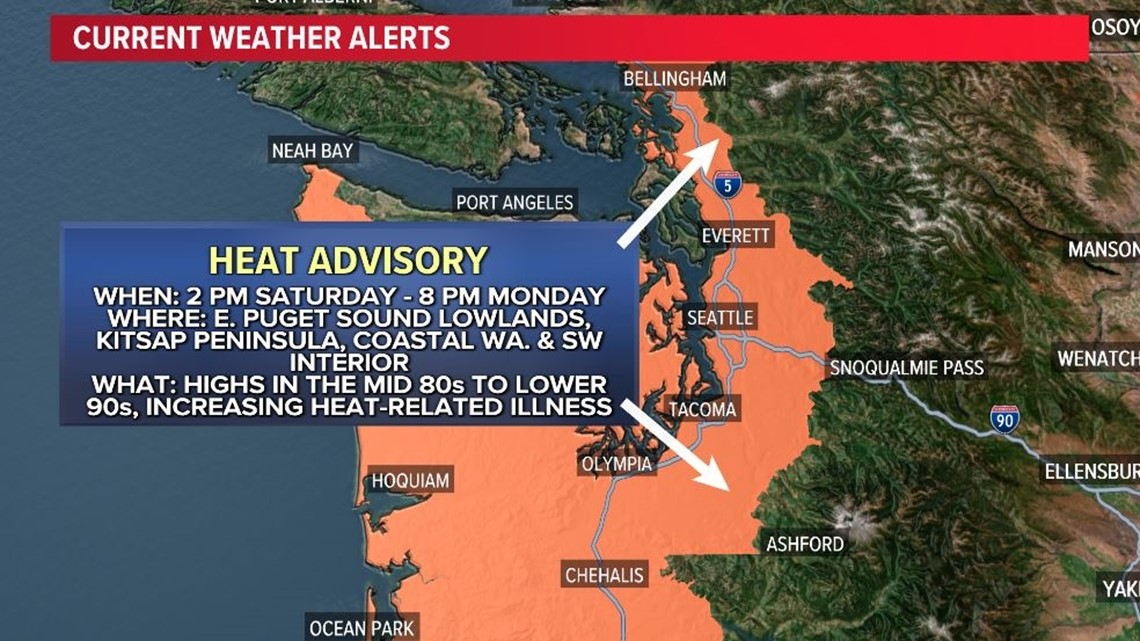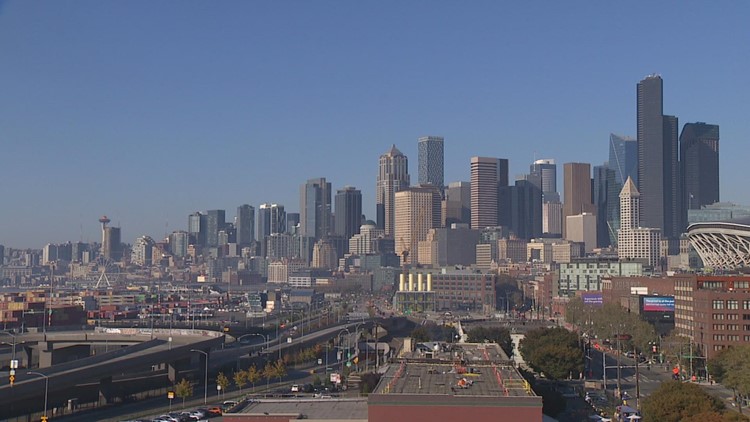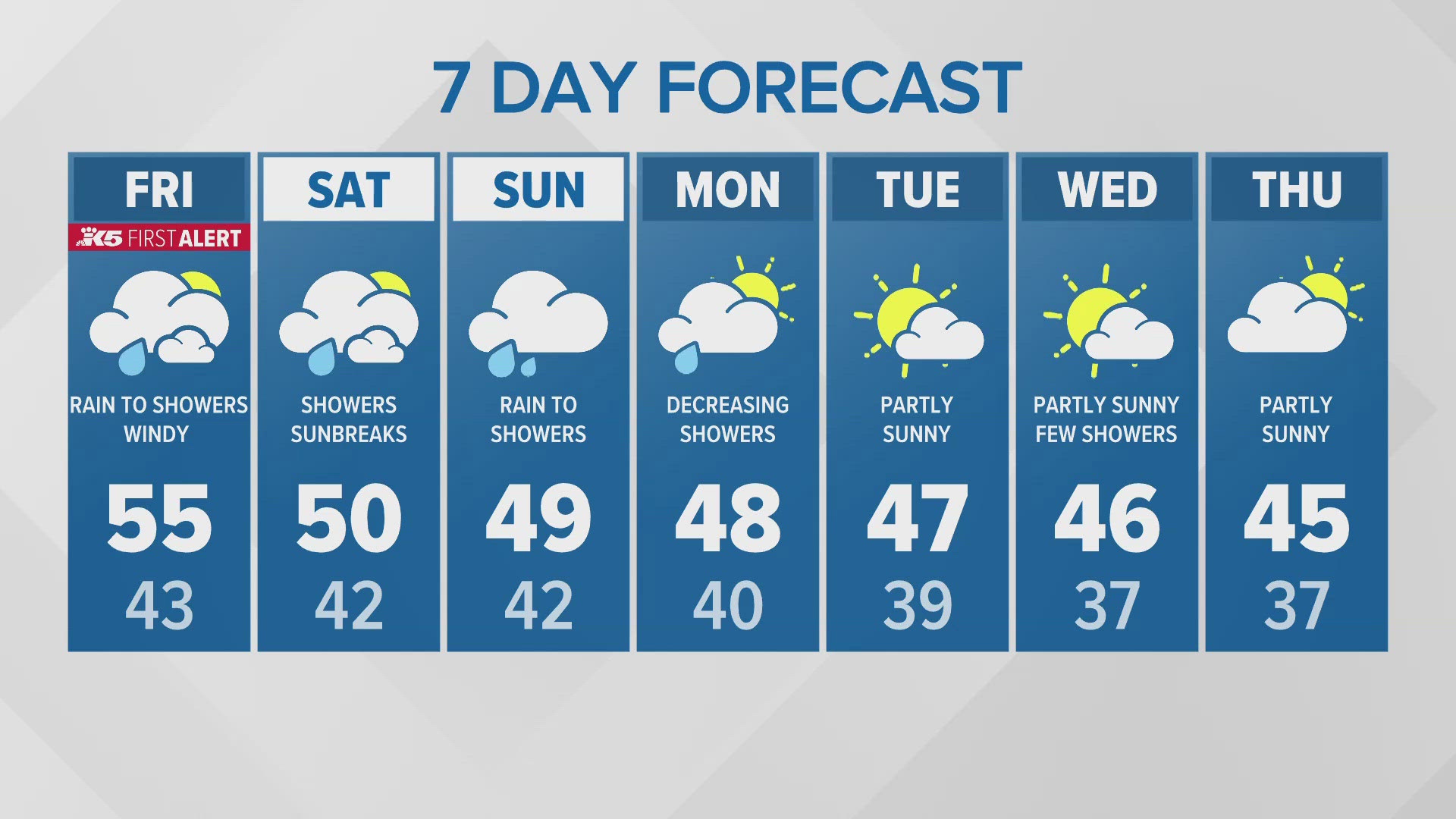SEATTLE — An early-season heatwave will bring an unprecedented stretch of record-breaking heat for the month of May. Because of the hot temperatures arriving so early in the year, and the potential associated health impacts coming off an unusually chilly spring, the Seattle National Weather Service issued a Heat Advisory for parts of western Washington.
The Heat Advisory goes into effect at 2 p.m. on Saturday continuing until 8 p.m. Monday. The Heat Advisory includes most of the Puget Sound lowlands, the Kitsap Peninsula, areas near the Hood Canal, coastal Washington, and the Southwest Interior. This does include Seattle, Everett, Bellevue, Tacoma, and Olympia where highs will surge over 20 degrees warmer than average, topping out in the mid to upper 80s and lower 90s. This will raise the concern for heat-related illness, especially for vulnerable populations.
Heat Advisory 2 p.m. Saturday until 8 p.m. Monday


The increased risk of heat-related illness, especially for vulnerable populations, paired with the very early warmth is a big reason why a Heat Advisory was issued for the area according to Reid Wolcott who is the warning coordination meteorologist at the Seattle National Weather Service.
Reid says many variables are assessed when weighing the option of issuing heat-related alerts in Seattle and across western Washington.
The Seattle National Weather Service utilizes an experimental heat risk index, known as HeatRisk when determining the issuance of heat-related alerts such as this weekend's Heat Advisory. This heat risk index is unique in that it provides a HeatRisk color-coded numeric index score ranging from 0 to 4 depicting the level of heat concern on a hyperlocal level. The 0 to 4 HeatRisk index score is assigned to a color going from green to magenta. Green (level 0) indicates minimal heat risk while magenta (level 4) indicates extreme heat risk.
National Weather Service experimental HeatRisk scale


Excessive Heat Warning, Excessive Heat Watch, Heat Advisory
Heat alerts are on a three-tier format system: warnings, advisories, and watches with warnings being the most severe and impactful of the three but all should be taken seriously. The issuance of these heat alerts from the Seattle National Weather Service can and typically does allow the opening of cooling centers and other resources to residents.
When determining which heat alert to issue, Reid says the meteorologists at the Seattle National Weather Service heavily weigh their decision on the HeatRisk forecast. A widespread score of 2 (orange) with some 3s (red), triggers a Heat Advisory, which is what western Washington is experiencing this weekend. Widespread scores of 3 (red) and some 4s (magenta) would trigger an Excessive Heat Warning for the region.
HeatRisk aims to quantify the risk based on how much hotter than normal the temperatures are for the area with the threshold changing throughout the year. With this index taking into account the time of year, it's essentially on a sliding scale in which the same temperatures in May that prompt the issuance of a Heat Advisory may not prompt one in August. This scale doesn't just take afternoon high temperatures into consideration, but nighttime lows are also included in the equation in which lows staying in the 60s and 70s would increase the heat risk.
This HeatRisk system has been used by many of the local National Weather Service offices in the western states to determine when to issue heat products since 2017 while many offices in more humid climates, east of the Rockies, tend to gauge the impacts of heat on people by weighting humidity and heat. The HeatRisk system is a better index and gauge of heat-related impact for western states where humidity is lower, but heat can still rise to dangerous levels, and helps provide a more finite, defined standard of alerting people about heat impacts.
Reid also says the lack of air conditions in western Washington weighs into the decision-making process on when to issue heat alerts as well as large outdoor gatherings such as big sporting events or festivals. Borderline temperatures for a heat alert paired with a large event that attracts a lot of people can be the tipping point to issue a heat alert.
As the temperatures heat up this weekend, it's important to remember that the water is still cold with water temperatures in the 40s and 50s. If you get into or on the water, wear the proper lifesaving safety devices.



